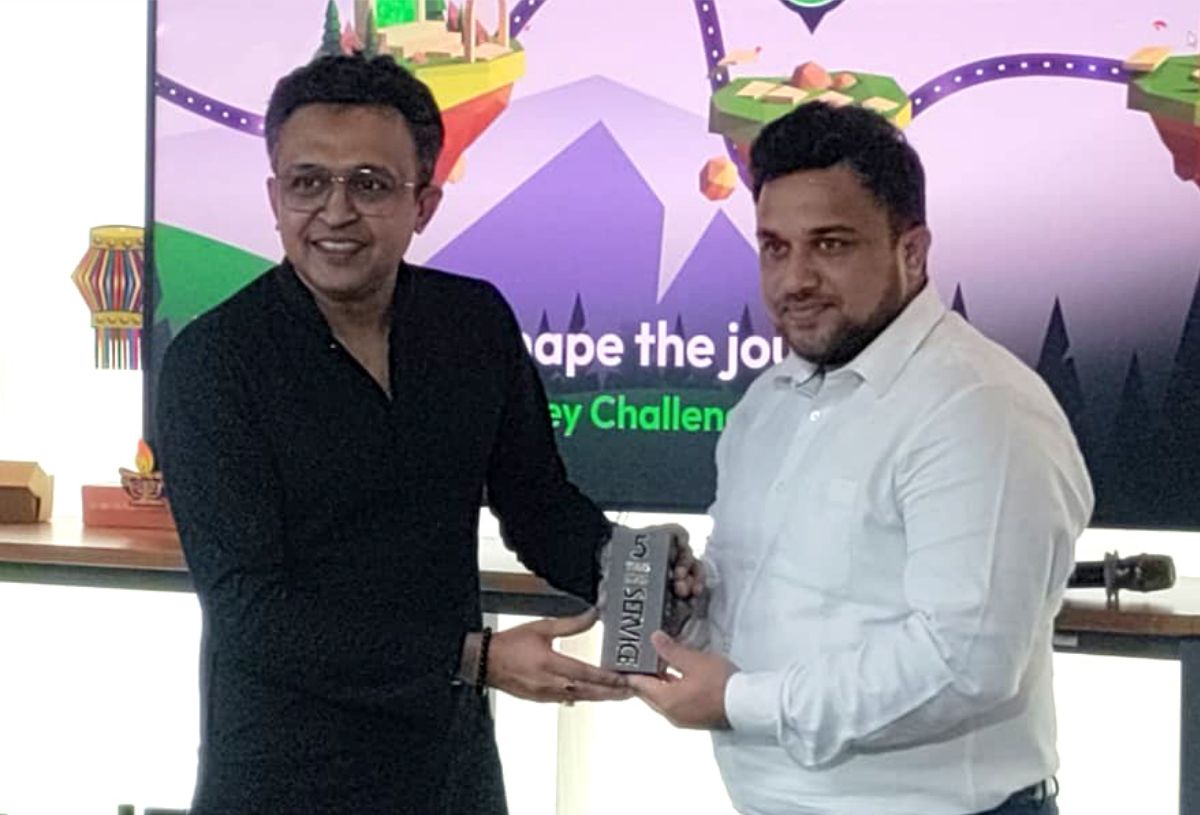Consolidating Employee Recognition Programs: Top Things to Consider
While it’s common for organizations to think about consolidating employee recognition programs after a merger or acquisition, there are many other reasons why you may want to centralize your recognition solutions.

Updated on
May 15, 2025
15
May
2025
In addition to simplifying and aligning employee experiences with recognition, consolidation provides greater ability for cross-functional recognition and better efficiencies in tracking recognition activity and budgets.
Employee recognition is an excellent way to connect employees to the same organizational purpose, values, and priorities that strengthen company culture and community. Consolidating recognition programs can ensure your employees have a more consistent, equitable, and meaningful recognition experience—all of which can impact employee engagement and employee retention. Research shows integrating recognition across an organization leads to higher connection, inclusion, and improved business outcomes.
Employees with integrated recognition in their culture are 4x more likely to feel high inclusion and 13x more likely to feel they belong at the organization.
Why should companies consolidate their employee recognition programs?
Most companies consolidate their recognition programs for these main reasons:
- Organizations have just completed a merger, acquisition, or added a new location and need to combine employee recognition programs.
- They have multiple, disparate recognition programs across their organizations and employees have a different recognition experience (and satisfaction) depending on where they work. Disparate recognition programs can also limit cross-function recognition, and companies may want to improve collaboration and teamwork.
- Companies have different recognition platforms to recognize years of service, above and beyond efforts, incentives, company celebrations, etc., and want a simpler, more streamlined and efficient process.
- Organizations have launched a new company brand or employee value proposition and want to ensure their culture of recognition is aligned.
No matter what the reason, organizations consolidating recognition programs all have the same goal: a consistent recognition framework and approach across the organization that provides an equitable experience for all employees.
Highly integrated recognition has a powerful impact, increasing odds of:
Great work by 13x
High engagement by9x
Thriving culture by8x

How to consolidate employee recognition programs
Once you’ve decided you want to consolidate your recognition programs, here’s how to do it:
1. Determine your recognition intention and goals
Clearly define what you want recognition to do at your organization and the problems you want recognition to help solve. Align your goals to your organization’s purpose and values and determine how you will measure them.
2. Assess current recognition practices
Do an assessment to collect information on what recognition is currently happening. What’s working well? What do employees find to be meaningful and impactful? What’s missing? Use a proven recognition framework to help you as you evaluate current recognition efforts and determine which aspects of current recognition practices you want to incorporate into your consolidated solution.
Learn how Chevron used surveys and assessments to understand current recognition practices, which informed successful program consolidation.
3. Design for outcomes
You likely need a partner to help you create a centralized recognition approach. Work with your partner to envision a total employee recognition solution that encompasses a wide variety of recognition (encouraging employees, recognizing achievements, celebrating careers, customer service, etc.) and create a new recognition brand that is aligned to your organization.
You’ll want to ensure recognition tools are accessible to all employees, regardless of level, type, or location and are flexible to meet their various needs. This could include mobile/offline solutions and location or business unit-specific considerations. Don’t forget to design experiences for public recognition, social media tools, and any symbolic awards to build community and connection. Engage IT teams early as you combine or implement new recognition software.
Want more advice on how to consolidate employee recognition programs? Chat with our experts.
4. Prepare and engage the organization
Regular, clear communication will be important as you roll out your new centralized approach. Discuss why you are consolidating recognition programs, the benefits it will have for employees, and what the new tools will entail. For many employees, consolidating recognition programs means they’ll experience changes, and communicating the why and how of that change is crucial to building support and adoption of your new solutions. Listen to employee feedback, give them a voice in the changes, and actively address their concerns. IAG used a comprehensive, people-focused change management strategy when they unified their enterprise recognition solutions.
5. Sustain and grow
With any new solution, you’ll want to review it regularly and evolve it over time. Get employee feedback, monitor recognition usage and satisfaction, and measure progress against your goals. Recognize employees who have helped with the consolidation and celebrate your successes. Continue to grow and expand your recognition efforts to create a culture of recognition for the long term.
Check out our eBook on how to find the perfect partner to help you consolidate your recognition programs.

What are the common challenges of combining employee recognition programs?
No matter the reason you consolidate employee recognition programs, there are a few common challenges you may face:
- Equitable to all. Empower all employees to give and receive recognition and ensure they have access to the same tools and recognition opportunities.
- Change management. Have a change plan that is infused with empathy and clearly communicates the reasons behind changes to your recognition approach.
- Rollout of new tools. Provide time, training, and resources for employees to learn new recognition tools.
- Data integration. Engage IT leaders early to help consolidate and integrate data from IT and HR systems.
- Communication and promotion. Build a robust and frequent communication strategy so employees know about your new approach and tools.
- A new recognition budget. Ensure your new solutions can track and assign recognition budgets and spend.
- Sustaining usage. Regularly review, expand, and evolve your recognition solutions to keep up with your growing needs.
Success stories of consolidating employee recognition programs

TD Bank Group
TD Bank Group wanted to simplify and streamline recognition by creating one enterprise program with a common rewards and recognition approach and brand, aligned to their company values and TD Shared Commitments. They were looking for simpler tools and technology and more flexibility and choice in recognition awards.
The company embarked on extensive strategy and assessment sessions with senior leaders and stakeholders across the bank to create TD Appreciate!. Their consolidated solution creates a consistent approach and standardized offerings with simplified budgets and processes. A network of recognition champions and leaders across the organization regularly promote the platform and communicate key metrics about recognition. As a result of TD’s efforts, over 90% of colleagues use TD Appreciate! and recognition has led to lower attrition rates (for both givers and receivers of recognition).
“Through collaboration with our business partners and O.C. Tanner, we’ve been able to drive the necessary tools and change required to manage appreciation and recognition more effectively.”
— Karey Stanley-Boyd, Head of Global Recognition Programs

American Airlines
American Airlines had a variety of recognition programs but was looking to better understand what and how much recognition was happening across the organization, expand their recognition offerings, and make recognition more accessible to all team members. They needed a partner and platform that could help combine their employee recognition programs and meet their growing needs to accommodate more types of recognition.
After gathering feedback from team members across the airline, American worked with O.C. Tanner to centralize recognition into an improved platform, Nonstop Thanks, that could recognize a variety of contributions and accomplishments. The new recognition platform fits well into the culture of American Airlines—a culture of commitment to and caring for team members. Since the launch of Nonstop Thanks, more than 4,700 recognition moments occur each day (equal to 3 recognitions per minute), and recognition plays an important role in unifying employees and strengthening their culture of caring.
“Having an easy and effective way to recognize our colleagues across the company is a crucial part of America's culture. The more focus we put on appreciating great work and key milestones the better we’ll be as an organization.”
— Ron Defeo, Senior Vice President of Global Engagement

CIBC
CIBC wanted to modernize how they recognize employees. While recognition was well-ingrained in their culture, the programs and processes to recognize needed updating. They were looking for a purpose-aligned, automated, and easy-to-use platform that could track recognition and make it more visible across the organization. O.C. Tanner worked with CIBC to create the MomentMakers program through the Culture Cloud platform.
Ecards, points for day-to-day great work and extra effort, nominations for above and beyond work, career milestone recognition, and recognition from onboarding to retirement are all done through MomentMakers and bring CIBC’s purpose and brand to life. The bank built an extensive network of 150 recognition champions across the bank to share information and updates about MomentMakers with executives and leaders in their business units.
Recognition has become an integrated part of the entire employee experience and CIBC culture, with eCard usage increasing 5x and award nominations increasing 9x compared to their previous program. 90% of employees feel “My manager gives me recognition for a job well done”, which is 6% higher than the industry benchmark and an increase of 7% from the previous year.
“Now we have a program where you can send an eCard or send a Purpose Award and it’s all captured in one system. You can look back at your history and see the great work you did and the recognition you received for it.”
— Justin Zelnicker, Senior Analyst, Recognition & Performance Enablement
Culture Cloud provides the most complete collection of streamlined employee recognition solutions on one recognition platform. Check it out today.
A research analyst with nearly 20 years’ experience, Christina uncovers employee perceptions and writes about the trends, insights, and best practices that create workplace cultures where people thrive. She uses her background in conducting and publishing primary research to tap into what the data says and why it matters to modern leaders. Christina has a bachelor’s in sociology from the University of Michigan and a master’s in marketing from Northwestern University.
A research analyst with nearly 20 years’ experience, Christina uncovers employee perceptions and writes about the trends, insights, and best practices that create workplace cultures where people thrive. She uses her background in conducting and publishing primary research to tap into what the data says and why it matters to modern leaders. Christina has a bachelor’s in sociology from the University of Michigan and a master’s in marketing from Northwestern University.
A research analyst with nearly 20 years’ experience, Christina uncovers employee perceptions and writes about the trends, insights, and best practices that create workplace cultures where people thrive. She uses her background in conducting and publishing primary research to tap into what the data says and why it matters to modern leaders. Christina has a bachelor’s in sociology from the University of Michigan and a master’s in marketing from Northwestern University.




